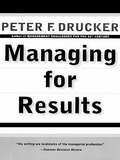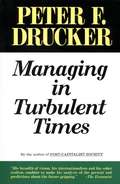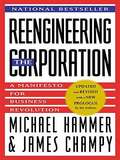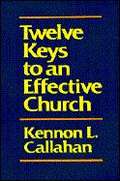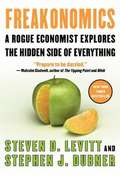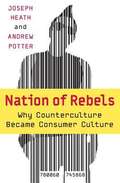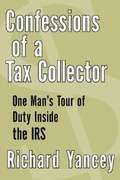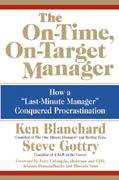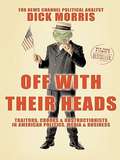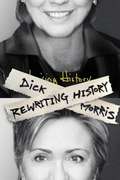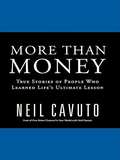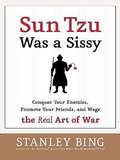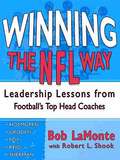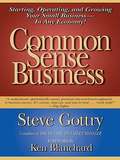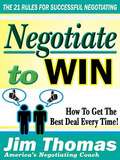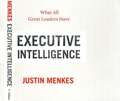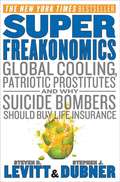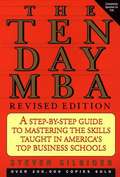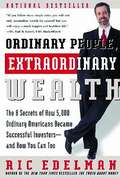- Table View
- List View
Managing for Results
by Peter DruckerThis is a "what to do" book. It deals with the economic tasks that any business has to discharge for economic performance and economic results. It attempts to organize these tasks so that executives can perform them systematically, purposefully, with understanding, and with reasonable probability of accomplishment. It tries to develop a point of view, concepts and approaches for finding what should be done and how to go about doing it. This book draws on practical experience as a consultant to businesses of all kinds and sizes for a good many years. Everything in it has been tested and is being used today effectively in real businesses. There are illustrations of, and references to, concrete situations on almost every page-
Managing in Turbulent Times
by Peter DruckerFuture management advice to practitioners and business students from a professor, reporter, and philosopher.
Reengineering the Corporation: A Manifesto for Business Revolution
by Michael Hammer James ChampyThe most successful business book of the last decade, Reengineering the Corporation is the pioneering work on the most important topic in business today: achieving dramatic performance improvements.
The Big Bing: Black Holes of Time Management, Gaseous Executive Bodies, Exploding Careers, and Other Theories on the Origins of the Business Universe
by Stanley BingFor twenty years, Stanley Bing has offered insight, wisdom, and advice. In one essential volume, here is all you need to know to master your career, your life, and, when necessary, other weaker life forms
Sick: The Untold Story of America's Health Care Crisis--And the People Who Pay the Price
by Jonathan CohnAmerica's health care system is unraveling, with millions of hard-working people unable to pay for prescription drugs and regular checkups, let alone hospital visits. Jonathan Cohn traveled across the United States--the only country in the developed world that does not guarantee its citizens access to medical care--to investigate why this crisis is happening and to see firsthand its impact on ordinary Americans. Passionate, powerful, illuminating, and often devastating, Sick chronicles the decline of America's health care system, and lays bare the consequences any one of us could suffer if we don't replace it.
Twelve Keys To An Effective Church
by Kennon L. CallahanSince it was published in 1983, the first edition of the original Twelve Keys to an Effective Church has benefited thousands of congregations from across the world. Now completely revised and updated, the second edition is even more useful and inspiring for congregations. The second edition of Twelve Keys to an Effective Church includes excellent suggestions on the five basic qualities for growing strong, healthy congregations and contains new possibilities and resources for implementing the Twelve Keys. It includes new material, wisdom, and insights on such important topics as mission, sacrament, and grace. Based on Kennon L. Callahan's many years of consulting with churches all over the world, this new edition will help leaders grow into strong, healthy congregations. This important resource can also be used to help build an effective, successful business, develop a strong non-profit grouping, advance an effective college or university, and create a strong, healthy family.
Freakonomics: A Rogue Economist Explores the Hidden Side of Everything
by Stephen J. Dubner Steven D. LevittIn Freakonomics (written with Stephen J. Dubner), Levitt argues that many apparent mysteries of everyday life don't need to be so mysterious: they could be illuminated and made even more fascinating by asking the right questions and drawing connections. Economics can explain a lot of real world every day situations.
Nation Of Rebels: Why Counterculture Became Consumer Culture
by Joseph Heath Andrew PotterIn this wide-ranging and perceptive work of cultural criticism, Joseph Heath and Andrew Potter shatter the most important myth that dominates much of radical political, economic, and cultural thinking. The idea of a counterculture -- a world outside of the consumer-dominated world that encompasses us -- pervades everything from the antiglobalization movement to feminism and environmentalism. And the idea that mocking or simply hoping the "system" will collapse, the authors argue, is not only counterproductive but has helped to create the very consumer society radicals oppose. In a lively blend of pop culture, history, and philosophical analysis, Heath and Potter offer a startlingly clear picture of what a concern for social justice might look like without the confusion of the counterculture obsession with being different.
Confessions of a Tax Collector: One Man's Tour of Duty inside the IRS
by Richard YanceyBeginning in the 1990s, Yancey worked for the Internal Revenue Service. At first he collected money from dilinquent taxpayers and was indifferent to the job, and then later he became more passionate as he worked to track down tax protesters. Soon he found that he was becoming obsessed with his job and began to feel isolated from everyone in his personal life.
The On-Time, On-Target Manager
by Kenneth Blanchard Steve GottryMillions look to Blanchard for innovative approaches to management, leadership, customer service, and much more. Now, he has joined with noted business author Steve Gottry to explore one of the most common and insidious problems plaguing the workplace -- procrastination. The On-Time, On-Target Manager is the story of Bob, a typical middle manager who puts things off to the last minute. As a result, he misses deadlines because his lack of focus causes him to accomplish meaningless tasks before getting to the important things. Like many professionals, Bob rationalizes, justifies, and tries to explain. Luckily, Bob is sent to his company's CEO -- which stands for "Chief Effectiveness Officer" -- who helps him deal with the three negative side effects of procrastination: lateness, poor work quality, and stress to himself and others. Bob learns how to transform himself from a crisis-prone Last-Minute manager into a productive On-Time, On-Target manager. With this engaging parable, Blanchard and Gottry offer practical strategies any professional can put into practice to improve his or her performance.
Off With Their Heads: Traitors, Crooks & Obstructionists In American Politics, Media & Business
by Dick MorrisConservative political analyst exposes the many ways he feels Americans have been lied to from the Clinton administration to the present day.
Rewriting History
by Dick Morris Eileen McgannConservative political annalist offers opinions on Hillary Clinton. Topics include Clinton's personality, money, hair style, intellect, and senate campaign.
More Than Money
by Neil Cavuto: True Stories of People Who Learned Life's Ultimate Lesson Author profiles the many business heroes who inspired him to continue his career through his battles with cancer and multiple sclerosis.
Sun Tzu Was a Sissy: Conquer Your Enemies, Promote Your Friends, and Wage the Real Art of War
by Stanley BingA modern version of the book The Art of War. Bing's setting is not a Chinese battlefield, but today's urban life, and In Bing's world, only loved ones are entitled to the smallest sliver of loyalty--everyone else is the enemy.
Winning the NFL Way: Leadership Lessons from Football's Top Head Coaches
by Robert L. Shook Bob LamonteIn this extraordinary collaboration with their agent Bob LaMonte, each of five coaches shares his leadership principles.
Common Sense Business: Starting, Operating, and Growing Your Small Business--in Any Economy!
by Steve GottryDo you own or plan to own a small business? " Do you work for a small business and desire to better understand your boss? " Do you know someone who owns a business and wants to be stronger, more focused, and more successful? This is the book for you. The truth is that many business books offer a lot of wonderful sounding theories, but they have little practical application in the real world of small business. Common Sense Business is full of life-and-death ideas. Follow Steve Gottry's advice and your business will live and thrive. Ignore it and your business could founder or die. Benefit from Gottry's experience as an entrepreneur who grew a hugely successful media agency, experienced a harrowing business failure, then rebounded with a new business and a fresh start on life. Common Sense Business tells you how to succeed throughout every phase of the small business life cycle -- from starting to operating, growing, and even closing down a business. No matter the state of the economy or the maturity of your business, you will find winning solutions to the questions and situations you face every day. Steve Gottry will help you understand yourself; your employees, customers, and vendors; and how people come together to form a successful business. You will learn how to maximize your business's assets and how to ward off those threats that could eat away at your resources and peace of mind, including debt, sloppiness, addiction, and fear. Warm, honest, funny, and factual, entrepreneur Steve Gottry tells the whole truth about successfully managing a business through good times and bad.
Go It Alone!: The Secret to Building a Successful Business on Your Own
by Bruce Judson<p>There is an epidemic of unhappiness in the American workplace. A full 70 percent of workers in the United States report that they are disengaged from their jobs. When asked, "Do you have the opportunity to do what you do best every day?" only 20 percent of nearly 2 million employees said yes. It is no wonder that 56 percent of all Americans dream of starting their own business. So why don't they do so? Because starting one's own business is seen as difficult, expensive, and risky. <p>In this extraordinary book, successful <i>Go It Alone!</i> entrepreneur Bruce Judson explains that the conventional wisdom about starting your own business is stunningly wrong. Using the leverage of technology -- e-mail, the World Wide Web, and the remarkable array of off-the-shelf business services now available -- it is dramatically easier to start your own business. Magnified by these new services, it is also possible to create, for the first time, a highly focused business. <p>Bruce Judson shows you the practical steps that will allow nearly any individual to create a business, often using job skills that seem to require an entire corporation for support. It is no longer necessary to spend time on the tasks that don't add value. It is now possible to stay small but reap big profits. Go-it-alone businesses allow the individual the freedom to concentrate on their greatest skills. After reading this book, your motto will be "Do What You Do Best, Let Others Do the Rest."</p>
Negotiate to Win: The 21 Rules for Successful Negotiating
by Jim ThomasNegotiation is one skill everyone needs in order to get more of what they want-to sell more, to earn more, to keep costs down, to manage better, and to strengthen relationships. In Negotiate to Win, master negotiator Jim Thomas shows you exactly how the best negotiators reach long-lasting, positive solutions-ones that build profits, performance, and relationships-with his 21 rules for successful negotiating. Learn how to overcome your natural reluctance to bargain, how to negotiate ethically (and deal with those who don't), and how to negotiate successfully across cultural lines. Negotiate with your boss, your children, your auto mechanic, and more. Once you learn how to negotiate to win, you'll always get the best deal.
Executive Intelligence: What All Great Leaders Have
by Justin MenkesThe final word on what traits make for highly successful managers - and a detailed explanation of how to identify potential standout performers. "Executive Intelligence" is about the substance behind great leadership. Inspired by the work of Peter Drucker and Jim Collins, Justin Menkes set out to isolate the qualities that make for the 'right' people. Drawing on his background in psychology and bolstered by interviews with accomplished CEOs, Menkes paints the portrait of the ideal executive.
Fast Food Nation: The Dark Side of the All-American Meal
by Eric SchlosserUsing first-rate reporting, wry wit and careful reasoning, Schlosser shows how fast food has harmed the American culture.
Superfreakonomics: Global Cooling, Patriotic Prostitutes, And Why Suicide Bombers Should Buy Life Insurance
by Stephen J. Dubner Steven D. LevittThe highly anticipated, explosive follow-up to the blockbuster "Freakonomics" offers another groundbreaking collaboration between Levitt and Dubner, an award-winning author and journalist. Don't miss reading the "notes" after the main content, there is more information in that section.
The Ten-Day MBA: A Step-By-step Guide To Mastering The Skills Taught In America's Top Business Schools
by Steven SilbigerAt the rate of one easy-to-understand chapter a day, this classic business book enables readers to absorb the material, speak the language, and acquire the confidence and expertise needed to succeed in today's competitive business world.
Small Is Beautiful: Economics as if People Mattered (25th Anniversary Edition)
by E. F. SchumacherSmall is Beautiful is the perfect antidote to the economics of globalization. As relevant today as when it was first published, this is a landmark set of essays on humanistic economics. This 25th anniversary edition brings Schumacher's ideas into focus for the end-of-the-century by adding commentaries by contemporary thinkers who have been influenced by Schumacher. They analyze the impact of his philosophy on current political and economic thought. Small is Beautiful is the classic of common sense economics upon which many recent trends in our society are founded. This is economics from the heart rather than from just the bottom line. Copyright © Libri GmbH. All rights reserved.
Making It into a Top College
by Howard Greene Mathew GreeneThis planning guide provides college-bound students and their parents with essential information on how the admissions process works; what the top colleges are looking for; choosing the right college; and presenting a student's qualifications.
Ordinary People, Extraordinary Wealth: The 8 Secrets of How 5,000 Ordinary Americans Became Successful Investors--and How You Can Too
by Ric EdelmanHow did a secretary, a firefighter, a retired naval officer, a housewife, a construction worker, a schoolteacher, and a pharmacist become wealthy? Bestselling author Ric Edelman has studied the wealth-making habits of these 5,000 other ordinary Americans and reveals his findings in this extraordinary book that outlines in eight easy, practical steps to achieving and maintaining wealth. Here you'll find a lifetime of wealth-building experience from people just like you -- people who have figured out how to arrange their finances and make wise investment decisions so that they can reach their goals and achieve financial security. Plus, you'll find tips on How to turn your mortgage into a wealth-enhancing tool Why small investments work better than big ones How to max out on your employer-sponsored retirement plan When to hold investments and when to fold them When to pay attention to financial news and when to turn it off Let your neighbours lend you a hand. And let Ric Edelman guide you through their lessons in this eye-opening journey with thousands of ordinary folks who found their way to extraordinary wealth.
